
- Source: ART BASEL
- Author: EMILY MCDERMOTT
- Date: JANUARY 31, 2022
- Format: ONLINE
OVR:2021 – Seven artists redefining photography
Highlights on display include Katharina Sieverding’s monumental images, David Benjamin Sherry’s monochrome landscapes, and Viktoria Binschtok’s data-mining methodologies
The upcoming edition of Online Viewing Rooms focuses on works produced in 2021. Among the wide range of artists, a significant number push the boundaries of a long-established medium: photography. From analog manipulations to the restaging of stock photos, the following artists continue to redefine what photography can be today
Since the 1960s, Prague-born German artist Katharina Sieverding (presented by Sabine Knust, Munich) has created images renowned for their monumental scale and powerful resonance. In her early works, she used en face portraits – frontal shots of individuals’ faces – to challenge gender roles, and she has since reckoned with everything from Nazism to the environment. One of her most recent pieces, Gefechtspause II (2020–21), combines one photograph from a meeting of the Chinese Communist Party with another of a police barricade opposing a Black Lives Matter demonstration in the United States. The work – rendered in red, white, and blue – addresses both US and Chinese political and social movements. More poignantly, however, it can also be read as a statement on the sociopolitical effects of a pandemic that originated in China, caused widespread discrimination against Asian people of various descents, and has disproportionately affected Black Americans.
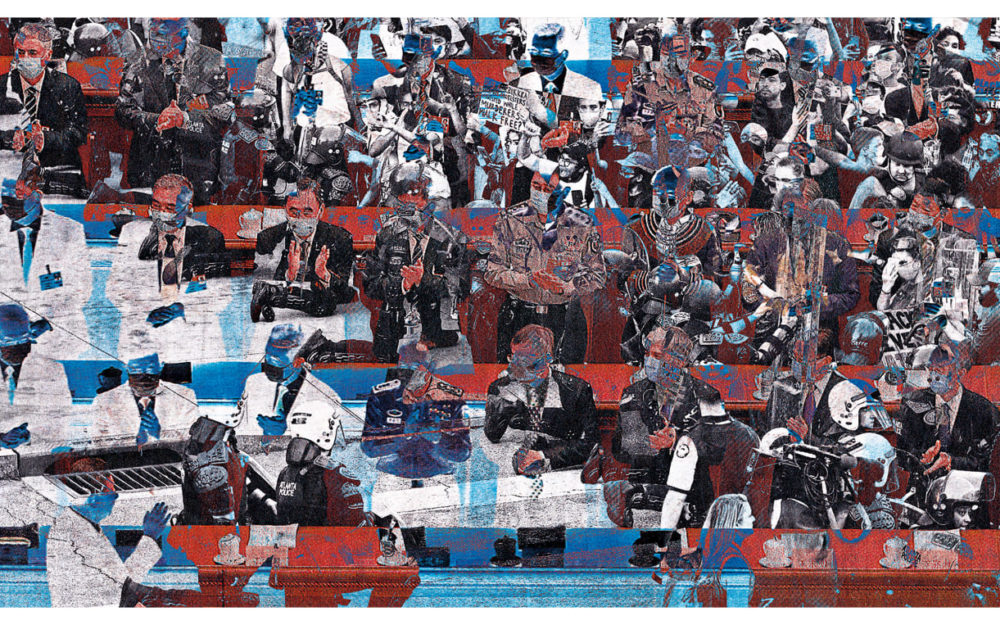
Katharina Sieverding, Gefechtspause II, 2020-21. Courtesy of the artist and Sabine Knust, Munich.
Colombian artist Johanna Calle (presented by Galeria Marília Razuk, São Paulo) also interlaces images, albeit with a different material approach. For her series ‘Tejido Fotografico’ (‘Photographic Fabric’, 2020–21), Calle cut found photographs into strips and wove them together, sometimes also incorporating cardboard or graph paper. At times she makes coy political statements, as with the series ‘Pie de Fotos’ (2012) and ‘Campo’ (2010), which recontextualize photos of crime scenes and land-reform movements, respectively. But as Rachel Mohl writes in the 2020 book Johanna Calle, Photo Graphias, the artist’s primary concern is to ‘transform the photograph from a unified memento mori into a multifaceted living object.’
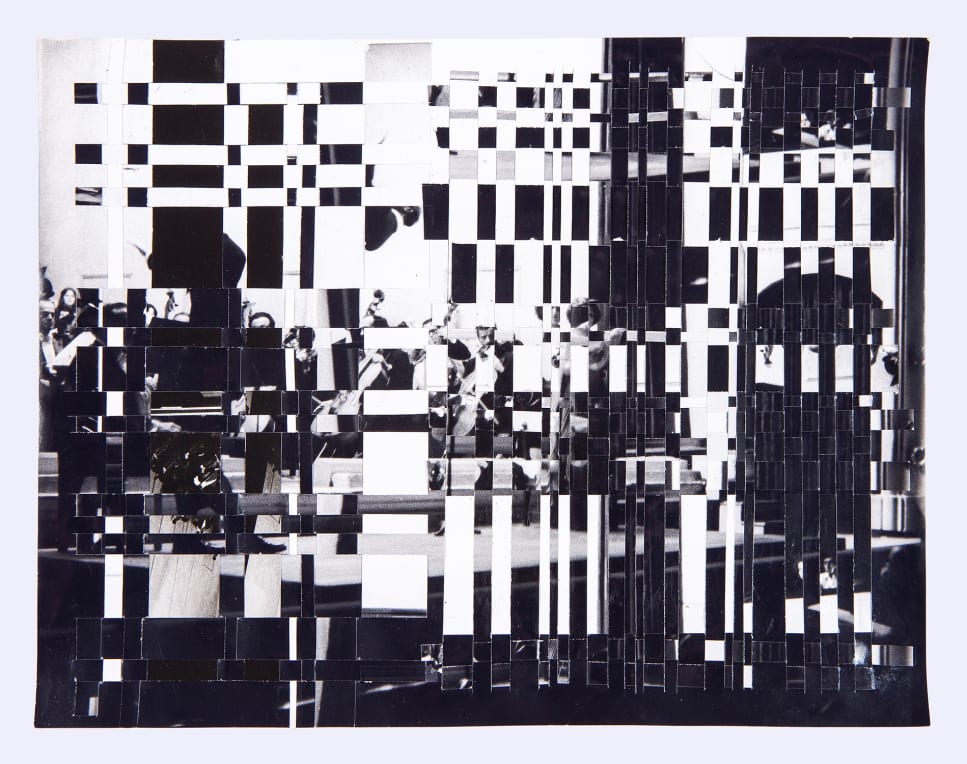
Johanna Calle, Orchestra (Black & White Photographic Fabric), 2021. Courtesy of the artist and Galeria Marília Razuk, São Paulo.
Viktoria Binschtok (presented by Klemm’s, Berlin) also transforms found photographs into living objects through the literal reconstruction of what she finds on the internet. For her ongoing series ‘Cluster’ (2014–), the Berlin-based Russian artist searches ‘by image’ on Google Images using her own photographs, allowing the algorithm to find supposedly similar imagery. She then restages one of the found photos and rephotographs it. Finally, she exhibits the resulting image and the original that she searched Google Images with, side by side, calling authorship and originality into question. In this series, as she has throughout her practice, Binschtok strips images of context, blurring the calculated work of a machine with the incalculability of an artistic gesture.
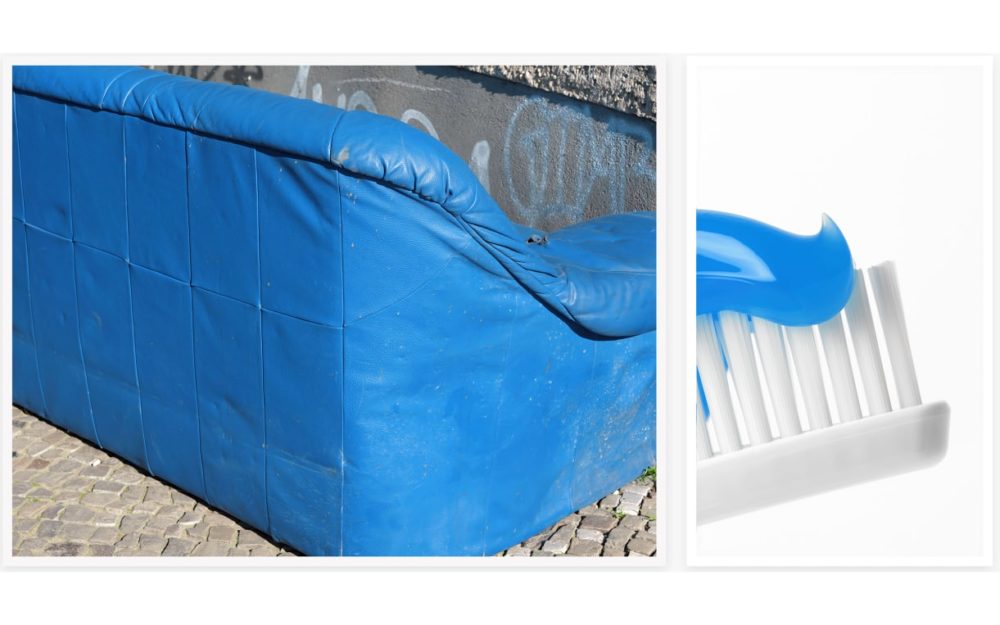
Viktoria Binschtok, Blue Sofa Paste, 2021. Courtesy of the artist and Klemm’s, Berlin.
Color and the landscape of the American West are the primary subjects of David Benjamin Sherry’s work (presented by Morán Morán, Los Angeles and Mexico City), but these seemingly straightforward environments grapple with weighty themes. Take his recent series ‘American Monuments’ (2019), for which landscape photographs, made with a large-format analog camera, were manipulated and printed in the darkroom in vibrant, monochromatic shades of blue, red, pink, orange, yellow, and green, as well as gray. But beneath their beautiful surfaces lies a darker truth. The featured landscapes are national monuments that were stripped of their protected status by the Trump administration for oil-, coal-, and uranium-related development. In addition to its environmental and political associations, the series also speaks to Sherry’s explorations of queer identity. ‘I am constantly made aware of my outsider perspective in the largely heteronormative spaces of rural America,’ he writes on his website. ‘My presence in the wilderness is, in a sense, a performance of “queering” these places[…]and I seek to convey this spirit in my photographs.’
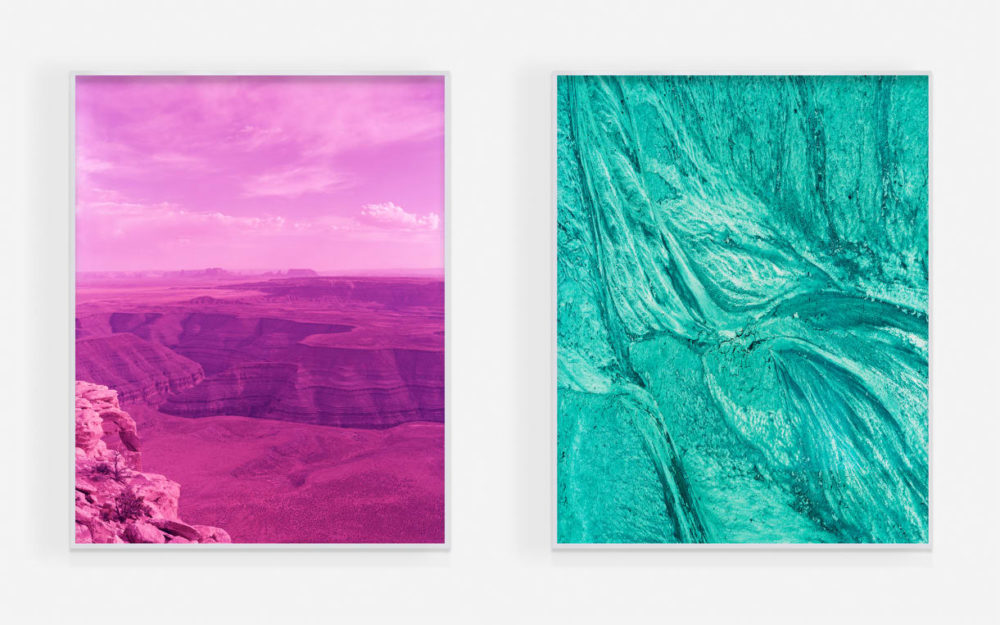
Left: David Benjamin Sherry, Bears Ears National Monument, Utah, 2021. Right: David Benjamin Sherry, Bisti/De-Na-Zin Wilderness, 2021. Courtesy of the artist and Morán Morán, Los Angeles and Mexico City.
Jill Orr (presented by This Is No Fantasy dianne tanzer + nicola stein, Melbourne) is known for site-specific performances, videos, and photographs also tied to landscapes. For the project Falling and Flight Reclaimed (2021), the Australian artist performed at Mitre Lake, a naturally occurring salt lake in Victoria, Australia. In photographs made during the performance, we see her dressed in robes like those of a missionary – at times carrying a cross, at others an unidentifiable object in flames – as she walks across the lake’s reflective surface, a salt crust that covers oozing black clay. The work points to both the environmental crisis at hand and the need to recognize Aboriginal land rights: Mitre Lake is in Wotjobaluk country, home to the few remaining Djurid Balug people of the Wotjobaluk tribe.
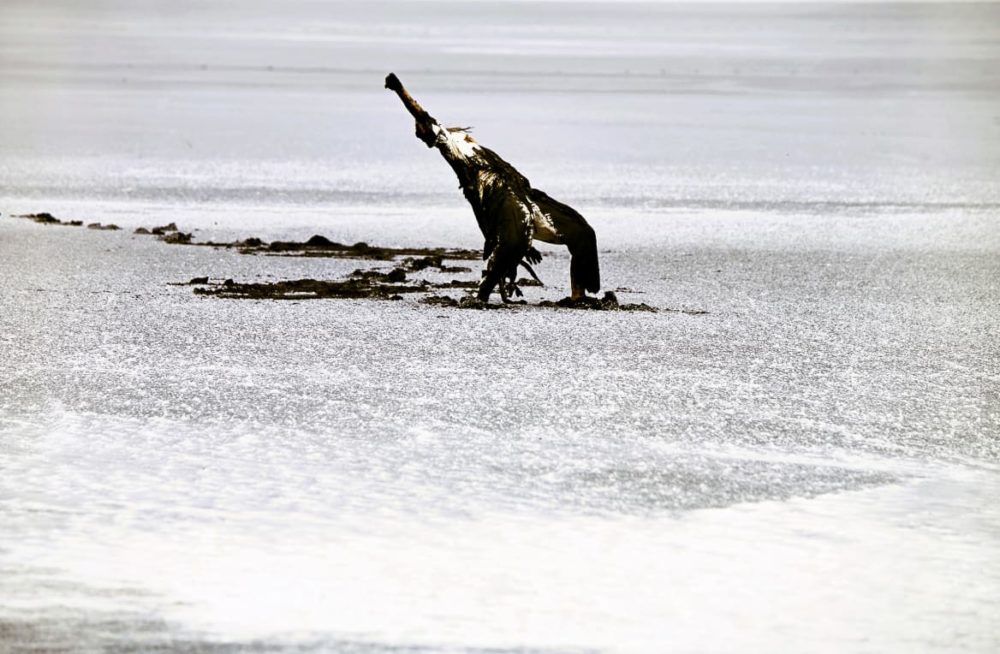
Jill Orr, Falling and Flight Reclaimed 03 , 2021. Courtesy of the artist and This Is No Fantasy dianne tanzer + nicola stein, Melbourne.
Photographic series by Sohrab Hura (presented by Experimenter, Kolkata) can often be read like personal journal entries, but they also have broader resonances. The Indian artist’s project ‘Snow’ (2015–), for instance, explores the idea of national identity through his generation’s relationship with the northern region of Kashmir. The photographs show snow as it first falls, as it blankets the landscape, and as it melts, using these phases of winter as a poetic metaphor for the region’s decades of political turbulence, stagnation, and unraveling. As Hura writes on his website, ‘I’m not attempting to tell the story of Kashmir but rather unearth the seeds of denial that had been sowed into my generation who [grew] up in the India of the 1980s–90s and thereafter burdened with the expectation to claim Kashmir as our own without any acknowledgement of occupation and the Kashmiri call for self-determination.’
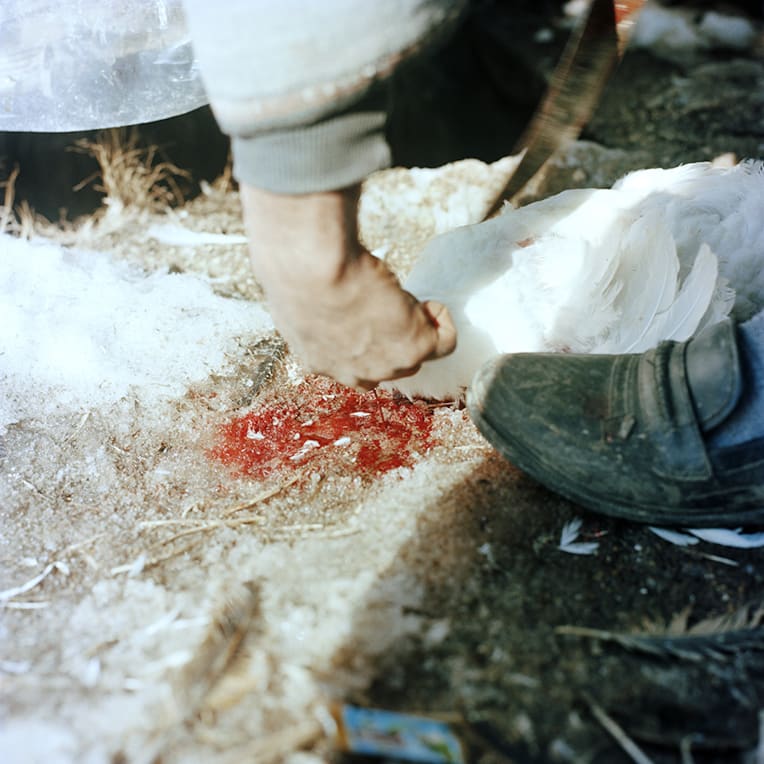
Sohrab Hura, Snow, 2015 - 2021. Courtesy of the artist and Experimenter, Kolkata.
A pivotal figure of underground cinema and queer zines of the 1990s, Scott Treleaven (presented by Cooper Cole, Toronto) has a practice that spans collage, film, video, drawing, photography, and installation. Most recently, he has translated a text-based cut-up technique popularized by William S. Burroughs into photographic language with an ongoing series of untitled collages. He creates bipartite constructions from more than two decades’ worth of his own 35 mm snapshots, pairing ancient marble statues with abstracted architecture and close-ups of flowers, a milky blue sky with a vase of flowers rendered in black and white. Collage – also a cornerstone of zines – has functioned as a theoretical fulcrum throughout the Canadian artist’s practice; it is a technique with which he disrupts images’ linearity, narrative, and spatial and temporal understandings.
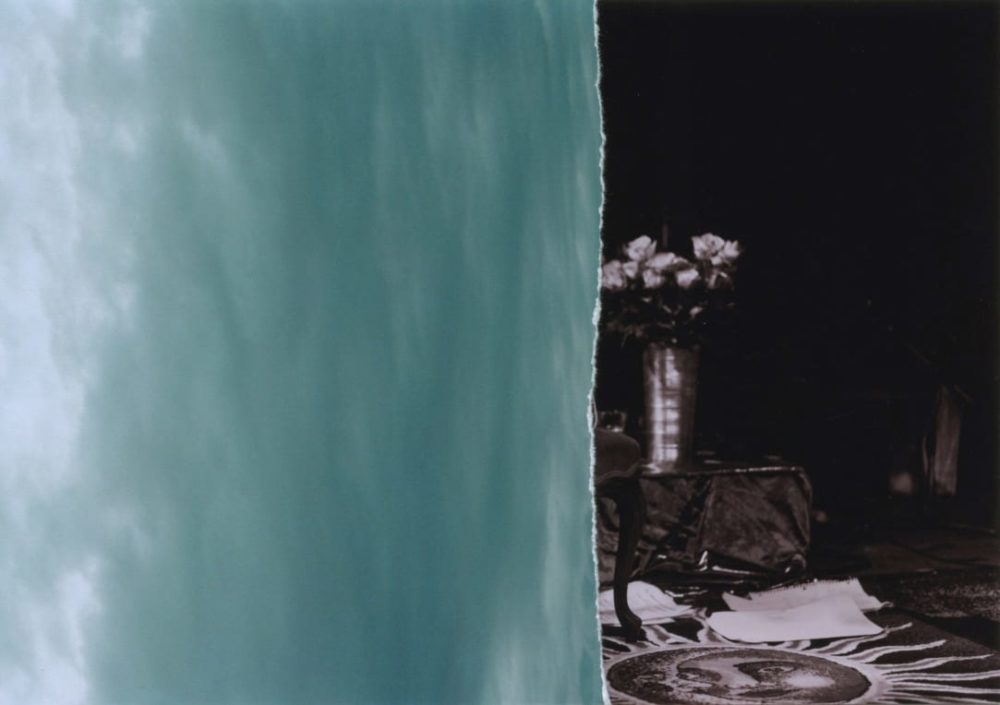
Scott Treleaven, Untitled (Wreck Beach sky/Thee Majesty performance), 2021. Courtesy of the artist and Cooper Cole, Toronto.

